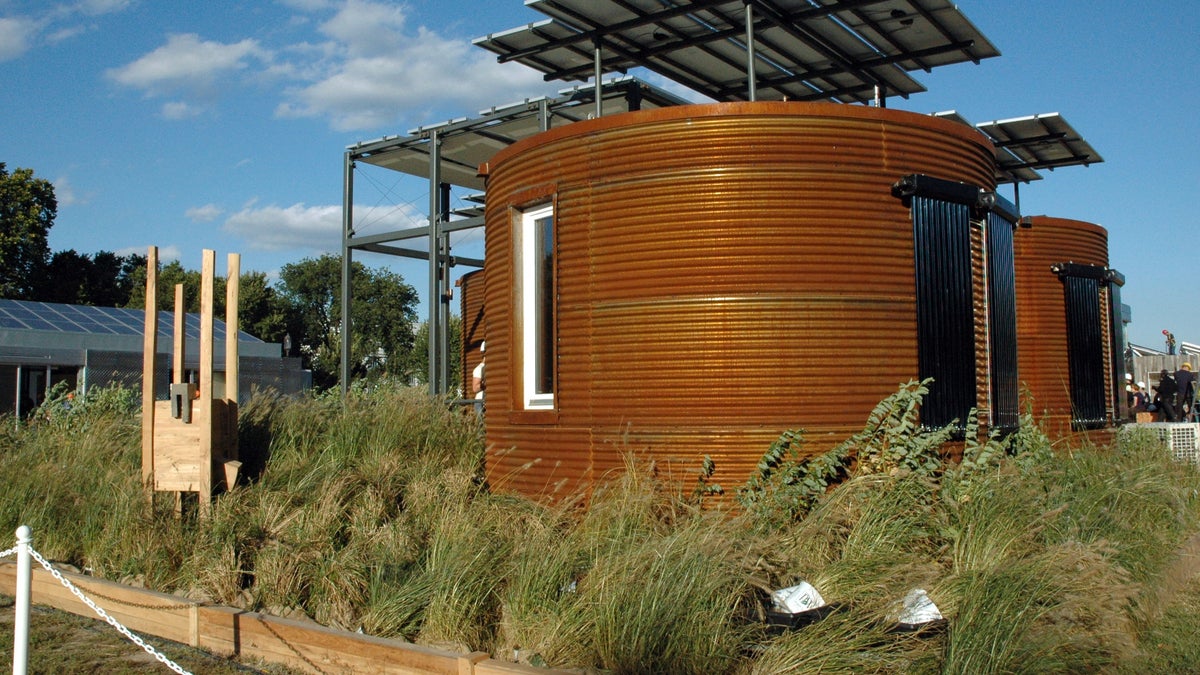Solar homes go for high-tech and practicality
Contestants from the Solar Decathlon in Washington build net zero-energy homes that push the envelope of green building design using solar and energy efficiency.

WASHINGTON--If you designed a net zero-energy home, would it be a science experiment or something you'd move into as soon as it was done?
At this year's Solar Decathlon student competition, both approaches were on display: high-tech homes that cost well over $700,000 and simpler ones that could be made for as little as $80,000.
The contest pits 20 colleges against each other to build the
Student competitors said the whole point was to show what's possible with existing solar and energy-efficiency products, either from established providers or green-building start-ups. And a look at these 800-square-foot structures shows you the huge variety of possibilities in net zero-energy buildings.
Teams Germany, Spain, and Ontario/BC built sophisticated and relatively expensive homes that used a number of innovative techniques, such as solar cells built into the homes' siding and high-tech heat sinks using "phase-change materials" that retain heat or cold to lower energy use.
Santa Clara University, which came in third in the 2007 competition, teamed up with California College of the Arts, to focus on changing the image of a green home.
"The big idea is that living green is not a compromise. You can have all the amenities of a modern house--you don't need to give up you high-definition TV," said Richard Navarro, an electrical engineering student at Santa Clara University. "If you go into this house, you wouldn't believe that it's just 800 square feet. It feels much bigger."
Many students said they designed buildings that they wanted to see back home. Penn State, for example, used solar collectors that work well with diffuse light and are well suited for their climate. Rice University's Zerow house will be installed as a low-income in Houston and Iowa State designed a home for seniors. The team from the University of Arizona, too, set out to build the "home of the future" tailored for their native state.
IT and building tech
On the technology side, the homes act as a showcase for tried-and-true products but also as test cases for relatively untested green building gear.
Many buildings used well established air-source heat pumps for heating and cooling buildings, which are considered efficient systems. Standard equipment in all these buildings included efficient home appliances and LED lighting, both of which keep the overall electricity demand down. Sensors were put in to automatically turn lighting--or even TVs--on and off.
Some student teams found ways to put cutting-edge products to work. Penn State's solar panels came from California start-up Solyndra, which makes arrays of curved tubes made of thin-film solar cells. Team Illinois worked with a young local company called Lamboo that makes lumber from bamboo--a plant that replenishes quickly. Bamboo is already used for flooring in new buildings, but Lamboo makes structural beams.
Many homes had advanced home-automation control systems, which are widespread in commercial buildings but rarely used in residential buildings. Ohio State, for example, has a system that knows how much power each outlet and appliance in the home is drawing. That data is collected and displayed on a touch screen so people can understand their usage patterns to find ways to be more efficient.
"The touch-screen energy display is not just cool technology. It's also a conservation tool," said Jared Lairmore, a graduate student in architecture at Ohio State.
But for all the focus on high-tech mechanical systems, students clearly also wanted these buildings to be attractive and fit in to their environments, rather than look like a "spaceship," as Kimberly Gould, a civil engineering student at University of Calgary and member of Team Alberta, put it.
A number of buildings used reclaimed materials, including planks from old barns, the core-ten steel used in corn silos, or, in Puerto Rico's case, teak from old wooden benches. Every home had a system to collect rainwater for their gardens, with Team California using a filtering system to clean drain water from the shower and kitchen sink.
"Energy efficiency doesn't mean it's different or not good to look at," said Chad Gallas, a graduate architecture student at the University of Kentucky. "It looks just like a home that could be done anywhere in Kentucky."
After the competition, some homes will be used as test labs or display back home. In the meantime, contestants are hoping to get the most points and share their ideas with the public.
"The way I look at it is we're building a Nascar (race car)," said Mark Taylor, assistant professor of architecture at the University of Illinois at Urbana-Champaign. "We put everything we could in, but you as the public can take what works for you."
The tentative date for the announcement for the overall winner is Friday, October 16. You can see the current standings here.

